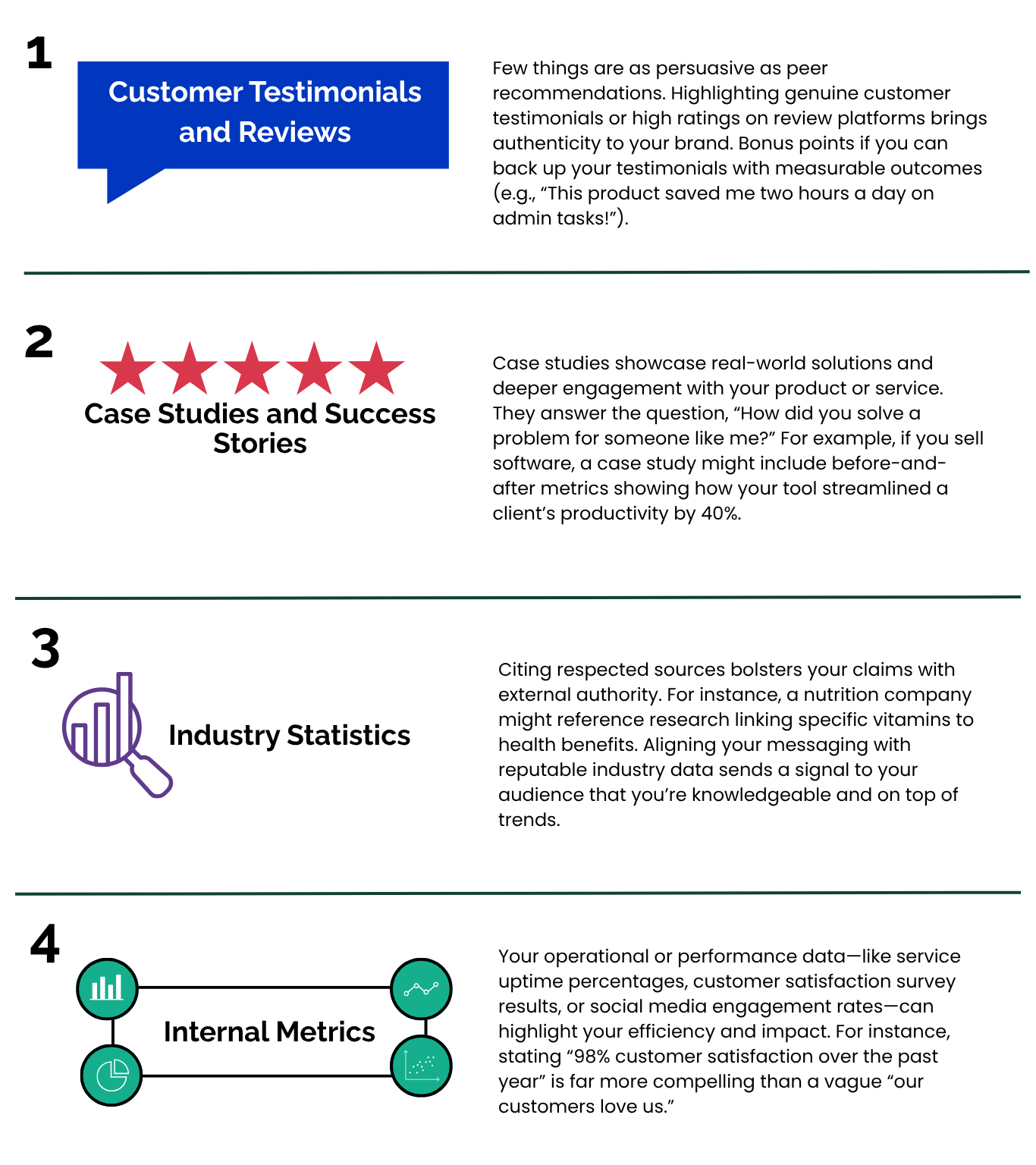Numbers Don’t Lie: Using Data to Elevate Your Brand
Trust is everything when it comes to building a successful brand. When brands are vying for attention and consumer trust, it's not enough to simply tell consumers you're trustworthy—you need to prove it. That’s where data-backed proof points come in. By leveraging facts, figures, and examples to substantiate your claims, you can reinforce your brand’s credibility, build customer confidence, and establish authority in your industry.
This article explores how to harness the power of data to strengthen your branding strategy. We’ll cover why data-backed proof points are essential, the kinds of data you can use, and practical ways to present this information effectively.
The Power of Data in Building Trust and Credibility
Modern consumers are increasingly skeptical. Marketing hype, endless choices, and exaggerated claims have made it harder for brands to stand out—or earn trust. Data, however, acts as an antidote to doubt. When you can show measurable proof of your product's performance, customer satisfaction, or market impact, you arm your brand with evidence that’s harder to dispute.
How Data Builds Trust
Consider this scenario: You’re shopping for a new skincare product. Brand A promises “flawless skin, fast.” Brand B shares clinical data, saying, “92% of users reported improved skin texture within two weeks.” Which would you choose? If you’re like most people, you’ll likely trust Brand B because their claim comes with validation.
Data does more than just verify facts, though—it humanizes your promises. Whether it’s a chart showing success rates or testimonials that connect with a customer’s real-world experiences, data gives your audience a reason to believe.
Credibility Is Key to Loyalty
Trust doesn’t just get your customers through the door. It keeps them coming back. Data-backed proof points demonstrate that you take accountability for your claims, reinforcing that your brand values transparency. This kind of consistent credibility is pivotal in turning first-time buyers into loyal advocates.
Types of Data to Support Your Brand
Not all data is created equal. To make an impact, the data you present should be relevant, specific, and tailored to resonate with your target audience. Here are four impactful types of data to consider integrating into your branding strategy.
How to Present Data Effectively
Having data is one thing; presenting it in a way that captivates and convinces your audience is another. Well-presented data not only enhances understanding but also ensures your proof points don’t get lost in the noise.
1. Use Visuals to Tell a Story
A compelling chart, graph, or infographic can instantly transform a sea of numbers into a clear, digestible takeaway. For example, instead of writing, “Sales increased by 25% in Q2,” show it in a bar graph alongside performance from other quarters.
2. Keep It Simple
Too much information can overwhelm. Focus on the one or two most impactful data points, and avoid cluttering your message with unnecessary details. Remember, you’re not writing a research paper—you’re giving your audience clear evidence to trust your brand.
3. Connect Data to Benefits
Your audience wants to know how the information you’re sharing impacts them. Translate metrics into tangible outcomes. For example, instead of saying, “Our software simplified 1,000 workflows,” you could reframe it as, “Our software saved customers an average of 3 hours per week.”
4. Use Comparisons for Context
Data points without context can fall flat. Providing comparisons—whether against competitors, past performance, or expectations—makes the number mean something. For instance, “Our energy-saving solutions cut utility costs by 15%, compared to the industry standard of 7%.”
Brands That Get It Right
Plenty of powerhouse brands have mastered the art of using data to solidify their reputation and connect with audiences. Here are two real-world examples that demonstrate the effectiveness of this approach.
Slack
Spotify’s “Wrapped” campaign is a brilliant example of using internal data to create a personalized customer experience. In 2022, over 120 million users engaged with the “Wrapped” feature, resulting in a 21% increase in social media shares related to Spotify content during the campaign period. By showcasing the listening habits of individual users at the end of each year, Spotify builds engagement and strengthens its image as a brand that profoundly understands its audience.
Salesforce
Salesforce effectively leverages data to showcase the superiority and proven impact of its platform for business customers. For instance, Salesforce’s 2022 Customer Success Metrics report highlights that companies using their CRM solution saw, on average, a 27% increase in sales revenue, a 32% improvement in customer satisfaction scores, and a 35% boost in team productivity. By sharing these concrete results, Salesforce demonstrates the tangible value and performance that its platform delivers in B2B environments, making its data-driven claims highly compelling to decision-makers.
Put Data at the Core of Your Branding
Data-backed proof points aren’t just a “nice-to-have” in today’s competitive environment—they’re a necessity. By integrating data into your messaging, you create a foundation of trust that can elevate your brand above the competition.
Start small. Identify one or two key data points that highlight your brand’s impact, and get creative about how you communicate them. Invest in infographics, collect meaningful testimonials, or even share a compelling case study.
The more evidence you provide for your value, the less you’ll need to persuade. Data speaks volumes—use it wisely, and watch your brand’s credibility soar.

